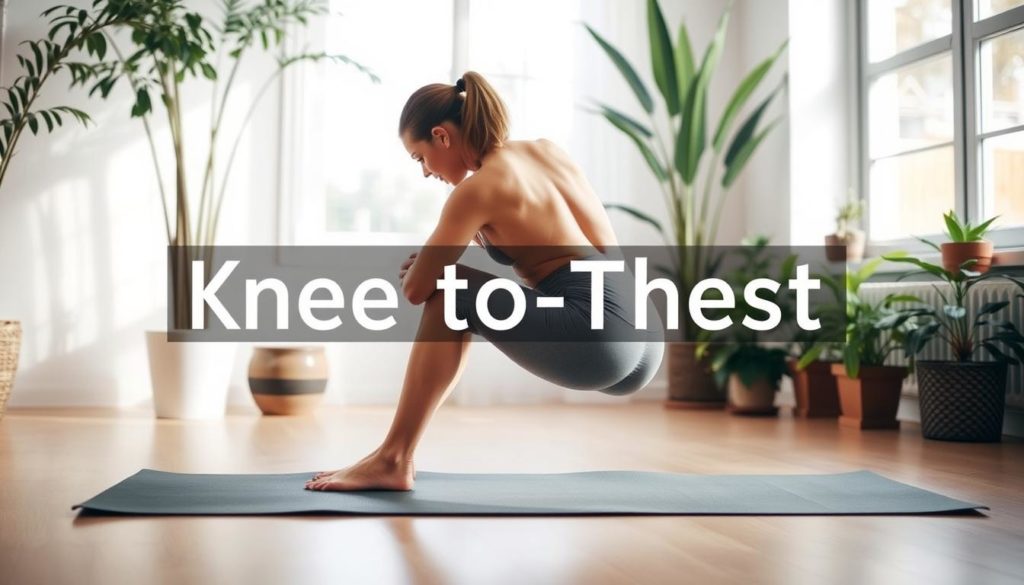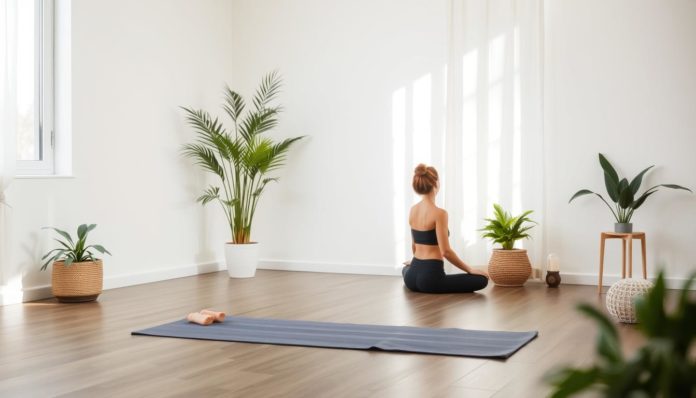Did you know nearly 80% of people in the U.S. will face back pain? This fact shows we need good ways to ease the pain. Stretching daily is a trusted way to find relief. It makes you more flexible, strengthens your muscles, and cuts down on pain.
It’s key to start slow with these stretches and then do more as you feel stronger. Always stay within your comfort zone to avoid injury. With advice from doctors, these stretches can greatly improve your life.
Knee-to-Chest Stretch
The knee-to-chest stretch is simple but very effective for back pain relief. It eases lower back tension and increases flexibility. We’ll go over how to do this stretch, its benefits, and ways to make it more comfortable.

Steps to Perform Knee-to-Chest Stretch
- Lie flat on your back with your knees bent and feet flat on the floor.
- Slowly bring one knee up toward your chest, gripping it with both hands.
- Keep the other foot flat on the floor while maintaining contact between your spine and the ground.
- Hold this position for 20-30 seconds, then slowly release.
- Repeat with the opposite knee.
Benefits of Knee-to-Chest Stretch
- Helps to relieve back pain stretches by loosening tight muscles.
- Improves flexibility and range of motion in the lower back.
- Can be easily integrated into a daily back pain stretching routine.
Modifications for Knee-to-Chest Stretch
- If experiencing discomfort, try pulling the knee gently and reduce the range of motion.
- Use a towel to assist in pulling the knee toward the chest to ease strain.
- For added comfort, perform the stretch on a padded surface or yoga mat.
Lower Back Rotational Stretch
The Lower Back Rotational Stretch helps ease pain and increase spinal flexibility. It’s easy to do at home without special tools. This makes it ideal for those with lower back pain.

How to do Lower Back Rotational Stretch
To get the most from the Lower Back Rotational Stretch, follow these steps:
- Lie down on your back on something comfy, such as a yoga mat.
- Bend your knees, keeping your feet flat on the ground.
- Stretch your arms out to the sides to keep your upper body stable.
- Gently twist your knees to one side. Make sure your shoulders stay down.
- Stay in this pose for 20-30 seconds, then go back to the start.
- Do the same stretch on the other side.
Why Lower Back Rotational Stretch is Effective
This stretch works well because it’s simple but powerful. Here’s why it’s good for you:
- Spinal Flexibility: It makes your spine more flexible, reduces stiffness, and improves motion.
- Muscle Engagement: Gently works the lower back muscles to help relieve pain without straining.
- Convenience: You can do this stretch anywhere, which is great for those always on the move.
Adding the Lower Back Rotational Stretch to your daily life can reduce back pain and improve spine health. When paired with other back stretches, it helps keep your lower back in top shape.
| Criteria | Details |
|---|---|
| Exercise Name | Lower Back Rotational Stretch |
| Main Benefit | Improves spinal flexibility and relieves lower back pain |
| Recommended Frequency | Daily or as needed |
| Preparation | Lie down on a comfortable surface like a yoga mat |
Lower Back Flexibility Exercise
Lower back flexibility exercises are key for a healthy spine and reducing injury risk. They improve motion range and give strong abdominal support. Tighten your belly muscles to lift and press your lower back to the ground. This helps align and strengthen your back.
Adding effective back pain stretches to your daily routine boosts spinal health. Rapid back pain relief is also a benefit. These exercises are vital for a complete back pain relief plan. They focus on increasing flexibility and support.
| Exercise Name | Benefits | Duration |
|---|---|---|
| Pelvic Tilt | Reduces lower back stiffness | 5-10 mins |
| Knee-to-Chest | Relieves lower back tension | 5-7 mins |
| Cat-Cow Stretch | Improves spine flexibility | 5 mins |
Bridge Exercise
The Bridge Exercise is great for easing back pain. It works the glutes, hamstrings, and lower back. By lifting the hips, a straight line is created from knees to shoulders. This brings big benefits for those seeking pain relief.
Step-by-Step Guide for Bridge Exercise
- Lie on your back with knees bent and feet flat on the floor, hip-width apart.
- Place your arms at your sides with palms facing down.
- Engage your core muscles and lift your hips toward the ceiling, forming a straight line from your knees to shoulders.
- Hold the position for a few seconds.
- Slowly lower your hips back to the starting position.
- Repeat 10-15 times.
Advantages of Bridge Exercise
- Improves posture by strengthening back muscles.
- Reduces lower back pain through targeted muscle engagement.
- Enhances core stability and hamstring flexibility.
Common Mistakes to Avoid
It’s important to follow the back pain stretch guide closely when doing the Bridge Exercise. This ensures the best results and helps avoid any injury:
- Over-arching the back: Ensure a neutral spine.
- Not engaging the core adequately: Maintain core activation throughout the movement.
- Incorrect foot positioning: Place feet directly under the knees for proper form.
Cat Stretch
The Cat Stretch is key to any good back pain stretching routine. It helps make the spine more flexible and eases tension. This movement involves arching and sinking the back while on hands and knees. It’s a popular yoga pose and easy to add to daily life.
To start the Cat Stretch, get on your hands and knees. Make sure your wrists are right under your shoulders and knees under your hips. Breathe in, arch your back, drop your belly to the floor, and lift your head up. This step is called ‘Cow Pose’ and it’s great for the lower back.
As you breathe out, round your back up, chin to chest, belly button pulling in. This step, known as ‘Cat Pose’, focuses the stretch on different muscles. This back-and-forth motion with your breath helps relax and engage muscles. It’s a full approach to stretches for lower back pain.
- Begin on all fours with hands and knees properly aligned.
- Inhale deeply as you arch your back, engaging in Cow Pose.
- Exhale slowly, rounding your spine into Cat Pose.
- Repeat the sequence, flowing smoothly between poses.
This stretch not only eases back pain but also uses breathing to help relaxation and wellness. Doing the Cat Stretch regularly can bring big relief. It’s a top choice for people wanting effective stretches for lower back pain.
Seated Lower Back Rotational Stretch
A relieve back pain stretch that works well is the twisted seated pose. It targets your lower back muscles. You can do it anyplace, which is great for those who sit a lot.
Instructions for Seated Lower Back Rotational Stretch
- Start by sitting on a flat surface with your legs extended.
- Bend your right knee and place your right foot on the outside of your left thigh.
- Twist your torso to the right, placing your left elbow on the outside of your right knee for support.
- Hold the stretch for 15-30 seconds and then switch sides.
Benefits and Modifications
The seated lower back rotational stretch comes with lots of benefits:
- Improved spinal flexibility
- Enhanced posture
- Reduced tension in the lower back
For an easier experience:
- Adjust the depth of the twist to what feels best for you.
- Sit on a cushion if your hips feel tight.
- Keep the outstretched leg slightly bent if it helps reduce tension.
Shoulder Blade Squeeze
The Shoulder Blade Squeeze is a key exercise for easing back pain. It’s very helpful for anyone who works long hours at a computer. This effective back pain stretch is easy to do.
To improve your posture and reduce pain in your upper back, try the Shoulder Blade Squeeze. Here’s the correct way to do it:
- Sit upright with your feet flat on the ground.
- Bring your shoulder blades together, as if you are trying to hold a pencil between them.
- Hold this position for 5-10 seconds.
- Release and repeat 10 times for the best effect.
This move fights the common issue of slouching forward. It also helps with better shoulder placement. Include the Shoulder Blade Squeeze in your exercises to make your back care more comprehensive.
Child’s Pose for Back Pain
Child’s Pose is a key yoga move for easing back pain. It stretches the lower back gently, which helps you feel relaxed and more flexible. It’s great for anyone needing simple lower back stretches because of its effectiveness.
How to Execute Child’s Pose
To get into Child’s Pose:
- Start by kneeling with your feet together and your knees apart.
- Gently sit back on your heels and stretch your arms out on the ground.
- Lay your upper body between your thighs and put your forehead on the floor.
- Stay in this position and breathe deeply to go deeper into the stretch.
Benefits of Child’s Pose for the Lower Back
Using Child’s Pose as a regular back pain exercise is very helpful. This exercise:
- Makes the lower back feel better by stretching it carefully.
- Helps you relax and stress less, which is good for easing back pain.
- Improves how flexible your spine and hips are.
By doing Child’s Pose often within a back-pain relief regimen, you’ll likely see lower back pain decrease. For additional exercises, check out this blog post on yoga poses that benefit the back.
Piriformis Stretch
The piriformis stretch is key for easing back pain, focusing on the muscle deep in your buttocks. It’s great for people with sciatic-like symptoms. It not only soothes back pain but also eases muscle and nerve tension.
Steps to Perform Piriformis Stretch
Start this stretch by lying on your back. Bend your knees with feet flat on the floor. Then cross one leg over so the ankle rests on the other knee.
Next, gently pull the knee towards your chest using your hands. You should feel a stretch in your buttocks. Hold this for 20-30 seconds. After that, switch legs and do it again.
Why Piriformis Stretch Helps Relieve Back Pain
The piriformis stretch targets the piriformis muscle. This muscle can press on the sciatic nerve, causing pain. Stretching it reduces this pressure. As a result, you feel less pain and move better. This stretch is a must for anyone with back pain issues.
FAQ
What is the Knee-to-Chest Stretch?
The Knee-to-Chest Stretch is a great way to ease lower back pain. It makes the lower back more flexible. You just pull one knee towards your chest, while lying down.
How do I perform the Lower Back Rotational Stretch?
To do the Lower Back Rotational Stretch, start by lying down with knees bent. Then, slowly twist your legs to one side without lifting your shoulders off the ground. It helps your spine move better and lessens back pain.
What are the benefits of the Bridge Exercise?
The Bridge Exercise boosts your posture and decreases back pain. It also makes your glutes, hamstrings, and lower back stronger. You lift your hips while lying down to make a straight line from knees to shoulders.
How do I perform the Cat Stretch for back pain relief?
For the Cat Stretch, start on your hands and knees. Move your back up and down, like a wave. It’s great for making your spine more flexible and easing tension.
What is the Seated Lower Back Rotational Stretch?
Sit on a chair, cross your legs, and turn your upper body to the side for the Seated Lower Back Rotational Stretch. It’s perfect for improving the twist in your lower back, especially if you sit a lot.
How does the Shoulder Blade Squeeze help with back pain?
The Shoulder Blade Squeeze fights upper back pain by pulling your shoulders back while sitting. It helps fix a slouchy posture and aligns your shoulders better.
How do I execute Child’s Pose for back pain relief?
To do Child’s Pose, kneel and stretch your arms out in front, then rest your upper body on your thighs. This pose softly stretches your lower back, giving you relief and a sense of calm.
What is the Piriformis Stretch and how does it help back pain?
The Piriformis Stretch eases pain in the buttocks and helps with sciatic-like pain. Lie down, cross your legs, and pull one knee to your chest. It relaxes the muscles around nerves, reducing pain.


